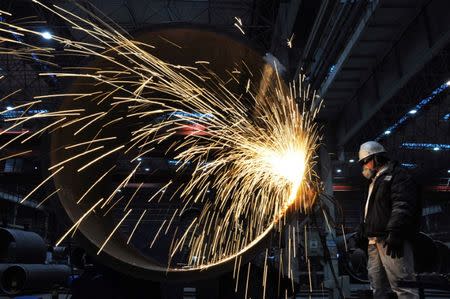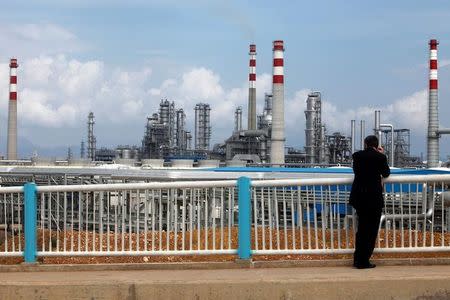China's March industrial profit growth slows sharply to over 1-year low
BEIJING (Reuters) - Profit growth at Chinese industrial firms slowed to its weakest pace in over a year in March, in a sign of increasing headwinds for the world's second-largest economy as policy makers navigate debt risks and a heated trade row with the United States.
Profits last month were up 3.1 percent year-on-year to 589.75 billion yuan ($93.10 billion), well below the 23.8 percent in the same period last year and the slowest growth since December 2016, official data showed on Friday. Earnings were up 16.1 percent over the first two months of the year.
The weak earnings were due to a later Lunar New Year holiday this year, softer producer price inflation, and higher financing costs due to currency conversion losses, He Ping of the National Bureau of Statistics (NBS) said in a statement accompanying the data.
After posting their strongest growth in six years last year, profit growth at China's industrial firms have slowed this year as a boom in commodity prices has started to fade, albeit very gradually.
"The strong recovery (in industrial profits) last year had much to do with the improvement in the producer price index," said Raymond Yeung, Chief Economist for Greater China at ANZ, noting that profit trends have generally tracked producer price levels.
"We don't expect deflation to return, so if we don't see a big negative contraction of the price level...the industrial profit (growth) figure will more or less stabilise over the next few months and especially the second half of the year.
Taken together, profits in the first three months of the year reached 1.55 trillion yuan, up 11.6 percent from the same period last year. That is still solid growth but a significant slowdown from the 28.3 percent pace in the same period last year.
In terms of demand, Yeung said it will vary by sector, with a slowdown in property and infrastructure construction hitting "old economy" sectors, while domestic consumption and the services sector will support demand.
Earnings for mining firms remained solid in the first quarter, rising 36.1 percent, while manufacturing profits rose 8.2 percent.
TRADE WAR RISKS
But profits in China's massive computer, telecommunications, and other electronics manufacturing sector fell 11 percent in the first quarter.
That is worrying especially as Washington has threatened to impose import tariffs on a range of Chinese goods, prompting warnings of retaliation from Beijing in an escalation of a trade spat that could impede growth globally.
Speculation is growing that China is considering shifting its monetary policy to a looser bias, as the threat of an all-out trade war with the United States adds to concerns about an expected loss of economic momentum.
The People's Bank of China (PBOC) last week cut reserve requirement ratios (RRR) for most banks, suggesting growth already may be starting to slow.
Weaker profit growth for China's vast industrial sector, which ranges from mining companies to high-tech manufacturers, also presents risks especially because state-owned firms are heavily indebted and account for the bulk of the country's high leverage.
Beijing is in the third year of a broad effort to curb a dangerous build up of debt across the economy, and so far appears to have successfully navigated the challenge of tempering financial risks without imperilling growth.
At the end of March, for instance, the liability to asset ratio for industrial firms was 56.4 percent, down 0.8 percentage points year-on-year, the stats bureau said.
China's economy expanded 6.8 percent year-on-year in the first quarter, matching the pace of the previous quarter, but analysts say slowing March industrial and investment growth suggest momentum is tapering off.
Factory inflation has cooled for five months now, hitting a 17-month low in March, and economists don't expect a bounce in the near-term.
Chinese iron ore futures had fallen over 17 percent through Thursday from highs for the year reached in January, though prices have risen in April as production picks up after a winter slowdown.
Profits at China's state-owned firms rose 23.1 percent to 476.3 billion yuan for Jan-March, compared with a 29.6 percent rise in the first two months.
($1 = 6.3347 Chinese yuan renminbi)
(Beijing Monitoring Desk and Elias Glenn; Editing by Shri Navaratnam)

 Yahoo Finance
Yahoo Finance 

